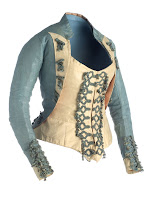During the XVII century there were two types of clothes:
 |
| Robe à la Françoise http://www.pinger.pl |
-Rococo style until the French Revolution.
-New classicism style after the French Revolution.
Female clothes:
-Robe à la Françoise:
This dress was formed by an inferior skirt and a superior skirt and a triangular bid which formed the superior part of the dress. The inferior part is completely formed by whalebones to give the shape to the dress.
-Dress coat (casaca):
It is a dress coat until the hip with a cut in the waist and wrinkles in the laterals from a button.

Dressing gown
http://www.google.es/imgres
-Chest guard (peto):
This chest guard closed the female dress in the frontal part.
-Dressing gown (bata):
This is characterized by flat wrinkles from the collar that toll up all the back and finish in a tail.
Male clothes:
-Jacket (chupa):
The front parts are cutting in one only piece. This have box collar and have pockets with wallet.
This was dressed up over the shirt and under the dress coat.
NEW CLASSICISM STYLE
Female clothes:
-Polonaise (Polonesa):
This dress known internationally like “robe á la polonaise” was the mode during the reign of Charles III.
This is characterized by the –abullonada- skirt in three parts and a slide cord in the middle.
-Vaquero:
This dress was opened in the front part, so we can see the inferior skirt. The body is formed by whalebones and close in the front. The back, the body and the skirt were cut in one only piece.
-Doublet (jubón):
This was fit to the torso and had a big rounded neckline. The back finishes off in the inferior corner of a smaller tail. The sleeve is long and narrow and has form in the elbow. There is other type of doublet that has neckband in the collar.
-Dress:
After the French revolution the dresses were inspired in the Greco-Roman world.
Male clothes:
-Suit “á la Françoise”
-Bid: peto
-Waist: cintura
-Button: botón
-Chest guard: peto
-Dress coat: casaca
-Wrinkle: arruga
-Collar: cuello
-Tool: bordado
-Tail: cola
-Box: caja
-Pocket: bolsillo
-Wallet: cartera / monedero
-Shirt: camisa
-Slide: deslizante
-Cord: cordón
-Whalebones: ballenas
-Fit: ajustado
-Sleeve: manga
-Neckband: tirilla
-Contour- contorno
ROCOCO STYLE
-Robe à la Françoise:
This dress was formed by an inferior skirt and a superior skirt and a triangular bid which formed the superior part of the dress. The inferior part is completely formed by whalebones to give the shape to the dress.
-Dress coat (casaca):
It is a dress coat until the hip with a cut in the waist and wrinkles in the laterals from a button.

Dressing gown
http://www.google.es/imgres
-Chest guard (peto):
This chest guard closed the female dress in the frontal part.
-Dressing gown (bata):
This is characterized by flat wrinkles from the collar that toll up all the back and finish in a tail.
 |
| Chest guard http://www.google.es/imgres |
 |
| Dress coat http://www.google.es/imgres |
-Jacket (chupa):
The front parts are cutting in one only piece. This have box collar and have pockets with wallet.
This was dressed up over the shirt and under the dress coat.
 |
| Jacket http://museodeltraje.mcu.es |
NEW CLASSICISM STYLE
Female clothes:
-Polonaise (Polonesa):
This dress known internationally like “robe á la polonaise” was the mode during the reign of Charles III.
This is characterized by the –abullonada- skirt in three parts and a slide cord in the middle.
-Vaquero:
This dress was opened in the front part, so we can see the inferior skirt. The body is formed by whalebones and close in the front. The back, the body and the skirt were cut in one only piece.
-Doublet (jubón):
This was fit to the torso and had a big rounded neckline. The back finishes off in the inferior corner of a smaller tail. The sleeve is long and narrow and has form in the elbow. There is other type of doublet that has neckband in the collar.
-Dress:
After the French revolution the dresses were inspired in the Greco-Roman world.
 |
| Polonaise http://museodeltraje.mcu.es |
 |
| Vaquero http://arqhisart.blogspot.com.es |
 |
| Dress http://museodeltraje.mcu.es/ |
 |
| Doublet http://museodeltraje.mcu.es |
-Suit “á la Françoise”
It is formed by a dress coat, jacket and a short. The jacket reaches until the knees, with wrinkles in the laterals and an opening in the part of the back. . The sleeve is long with form in the elbow. The dress coat has box collar body of straight contour and trapezoid skirt.
 |
| Suit "á la Francoise"http://www.fotolog.com |
VOCABULARY:
-Bid: peto
-Waist: cintura
-Button: botón
-Chest guard: peto
-Dress coat: casaca
-Wrinkle: arruga
-Collar: cuello
-Tool: bordado
-Tail: cola
-Box: caja
-Pocket: bolsillo
-Wallet: cartera / monedero
-Shirt: camisa
-Slide: deslizante
-Cord: cordón
-Whalebones: ballenas
-Fit: ajustado
-Sleeve: manga
-Neckband: tirilla
-Contour- contorno
1 comment:
Hello Pilar,
I´ve found this wensite in English. You can use it to correct the vocabulary mistakes and maybe to take some pictures:
http://www.thecostumersmanifesto.com/costumeoldsite/classes/fashiondress/18thCent.htm
Have a special look to the video, because thay explain how to dress every piece of cloth.
These are the corrections I have:
- Fashion clothes
- 18th century: you can´t use Roman numerals for centuries.Only Arabic numerals.
- French Revolution always in capital letters
- New Classicist style
- Women´s clothes and men´s clothes
- Robe à la Française, Polonaise... These words are also in capital letters in French
Please, check the specific vocabulary of the clothes with the link I´ve given you. I´m not an expert in fashion. And if you want to write an extra post about any other topic, please tell me before. It´s better, because I can give you advice and some links to avoid translating from Spanish.
See you!
Post a Comment